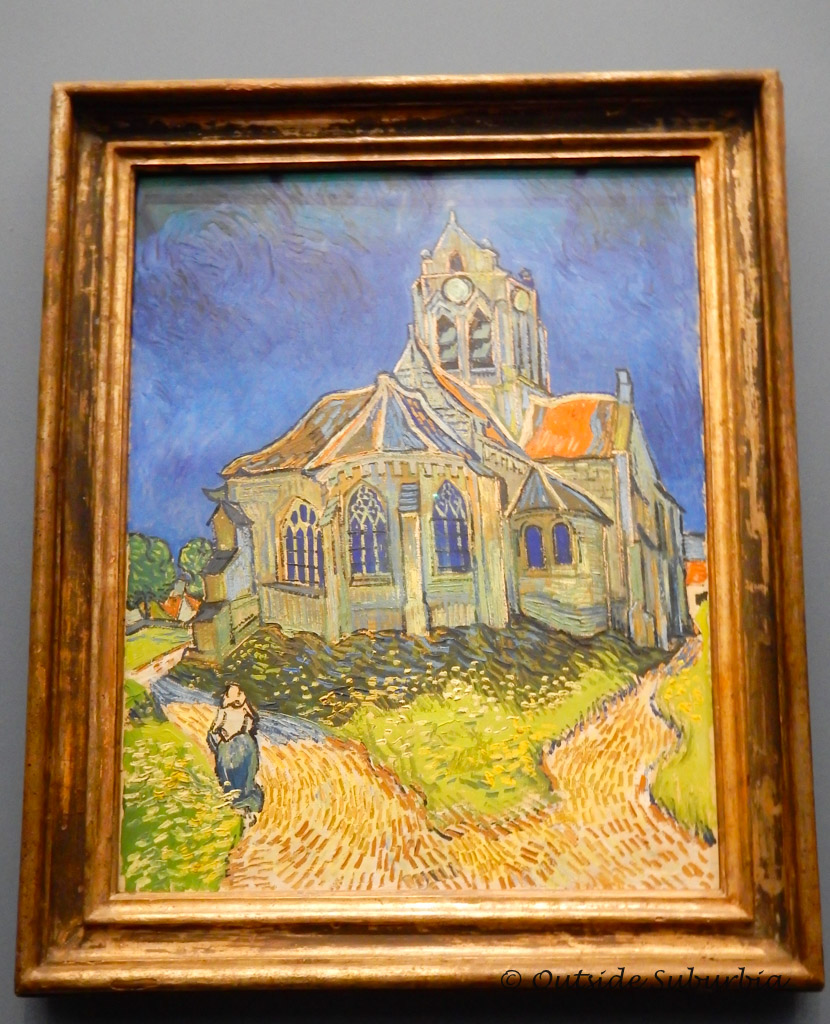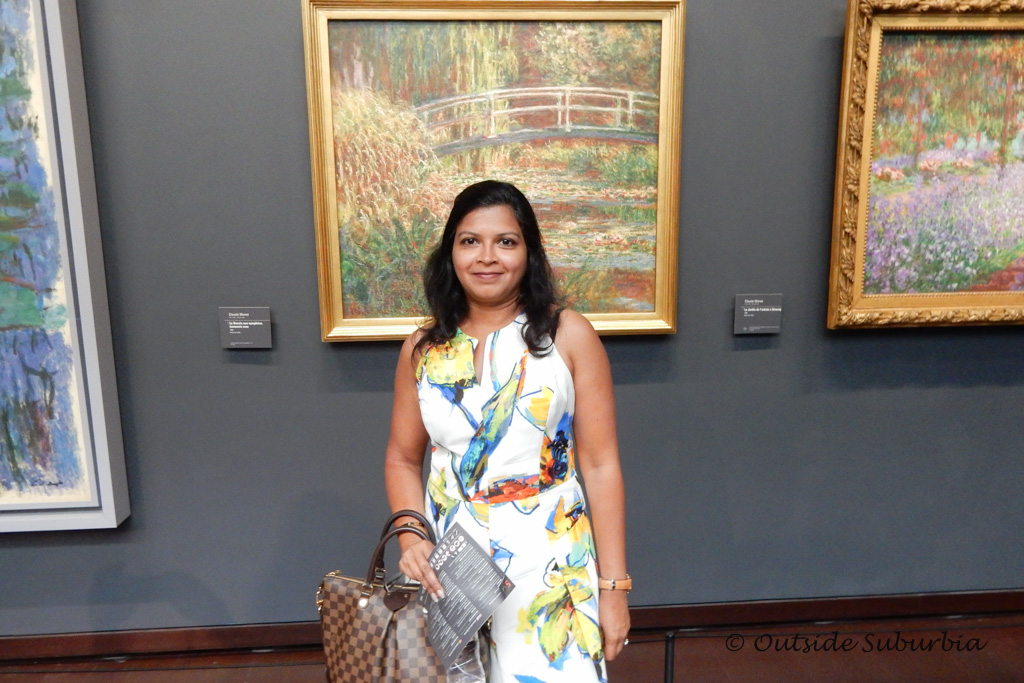“I don’t know anything with certainty, but seeing the stars makes me dream.” Van Gogh is known to have said. From the moment of his arrival in Arles, on 8 February 1888, Van Gogh was constantly preoccupied with the representation of “night effects”. He painted 3 versions of it. Vincent Van Gogh’s The Starry Night painting at Musee d’Orsay is more serene, an atmosphere reinforced by the presence of a couple of lovers at the bottom of the canvas.

WHAT IS IN THIS POST
Musee d’Orsay, Paris
The history of Musee d’Orsay, Paris building is quite unusual. It is located in the center of Paris on the banks of the Seine, right opposite to the Tuileries Gardens(where the Musee de Orangerie is located). The museum was installed in the former Orsay railway station which was built for the Universal Exhibition of 1900. The building itself is a “work of art” and I love photographing the big clock faces and the view from them. Musee d’Orsay displays collections of art from the period 1848 to 1914. You can see an overview of their collection here.

The central train station was built on the site of a ruined Palais d’Orsay. The station was designed so that it perfectly integrated into the elegant surroundings of the nearby Louvre and the Palace of the Legion of Honour (Palais de la Légion d’honneur).
The museum’s gallery spaces and facilities are distributed throughout its three levels: the pavilion Amont, the glass walkway of the former station’s western pinion, the museum restaurant which is installed in the dining hall of the former hotel, the Café des Hauteurs.



Van Gogh Paintings at Musee d’Orsay Paris
In addition to several Impressionists’ works Musee d’Orsay, Paris has a great collection of Vincent Van Gogh works. These post-impressionist works are some of my favorites. The Françoise Cachin Gallery at Musee d’Orsay displays the works of Van Gogh, Paul Gauguin, Emile Bernard and more.

The 1890s were characterized by an extraordinary profusion of creativity in the Parisian art world. With impressionism in the 1870s, Paris asserted itself as the capital of an independent form of art. As both a continuation of, and break from, this movement, a trend named ‘post-impressionism’ emerged at the end of the 1880s.
Vincent Van Gogh arrived in Paris in 1886. He soon explored the expressive possibilities of color. Paul Gauguin and a new generation of painters like Émile Bernard, Paul Sérusier, Meijer de Haan also affirmed the strength of color, while pursuing a radical simplification of forms. Odilon Redon, the leading light of symbolism, placed dreams and suggestions at the heart of his art. (Adapted from the text at Musee Orsay, Paris)
Here are some of the Van Gogh paintings you don’t want to miss at the Musee d’Orsay










Vincent Van Gogh, Starry night Paintings and where you can find them now
Van Gogh was self-taught and produced more than 2,000 oil paintings, watercolors, drawings, and sketches. All of which became in demand only after his death. He also wrote many letters, especially to his brother Theo, in which he worked out his thoughts about art. “Always continue walking a lot and loving nature, for that’s the real way to learn to understand art better and better,” he wrote in 1874. “Painters understand nature and love it, and teach us to see.” All his painting including the famous Starry Night shows Gogh’s use of simplified forms, thick impasto, and boldly contrasting colors that have made the work so compelling and unique.

In April 1888, Van Gogh wrote to his brother Theo: “I need a starry night with cypresses or maybe above a field of ripe wheat.” In June, he confided to the painter Emile Bernard: “But when shall I ever paint the Starry Sky, this painting that keeps haunting me” and, in September, in a letter to his sister, he evoked the same subject: “Often it seems to me night is even more richly coloured than day“. During the same month of September, he finally realized his project that he obsessed over.

Wondering where Starry Night is currently on display? Van Gogh painted 3 versions of Starry Night. He first painted a corner of nocturnal sky in Cafe Terrace on the Place du Forum, Arles (located in at Rijksmuseum Kröller-Muller, Otterlo). Next came the Starry Night over the Rhone which is housed at the Musee Orsay in Paris. In this version, he paints in pretty shades of blue: Prussian blue, ultramarine and cobalt along with a couple down at the bottom. The city gas lights glimmer and are reflected in the water while the stars sparkle in the sky.

A few months later, just after being confined to a mental institution, Van Gogh painted another version of the same subject: Starry Night (New York, MoMA), in which the violence of his troubled psyche is fully expressed. Trees are shaped like flames while the sky and stars whirl in a cosmic vision.
Van Gogh wrote of his experience to his brother Theo: “This morning I saw the country from my window a long time before sunrise, with nothing but the morning star, which looked very big.” This morning star, or Venus, may be the large white star seen on the left of center in The Starry Night painting. The hamlet, on the other hand, is invented, and the church spire evokes van Gogh’s native land, the Netherlands.
Facts about “The Starry Night”
Van Gogh considered “The Starry Night,” which one day would rank among his most famous works, to be a failure, according to what he wrote to his brother. The painting resonates with art fans in part to its vibrant palette and to the swirling motion that seems to draw viewers right into the center of the artist’s vision.

Vincent Van Gogh painted “Starry Night” in 1889 from a room in the mental asylum at Saint-Remy where was recovering from mental illness and his ear amputation. Van Gogh was allowed more freedom than any of the other patients. Someday he could leave the hospital grounds with an attendant and be allowed to paint, read, and withdraw into his own room. He was even given a studio.
While he suffered from the occasional relapse (he had been diagnosed with epileptic fits) his mental health was recovering while at the asylum. The artist’s fondness for yellow in paintings like “Starry Night” is said to be the result of taking too much digitalis, a treatment in his day for epilepsy.

Van Gogh painted the view from his east-facing window in the asylum 21 times. Although the series depicts various times of day and night and different weather conditions, they all include the line of rolling hills in the distance. None show the bars on the window of his room.

Physicist Jose Luis Aragon compared the turbulent play of light and dark in “Starry Night” to the mathematical expression of turbulence in such natural occurrences as whirlpools and air streams. He found they matched very closely. Aragon suggests that since the artist created these particular artworks during periods of extreme mental agitation, Van Gogh was uniquely able to accurately communicate that agitation.

Analysts of “Starry Night” emphasize the symbolism of the stylized cypress tree in the foreground, linking it to death and Van Gogh’s eventual suicide. However, the cypress also represents immortality. In the painting, the tree reaches into the sky, serving as a direct connection between the earth and the heavens.
The artist may have been making more of a hopeful statement than many don’t credit him with. This positive interpretation of the cypress symbolism hearkens back to a letter to his brother in which the artist likened death to a train that travels to the stars.

Since this room did not look out upon the mountains but rather had a view of the asylum’s garden, it is assumed that Van Gogh composed The Starry Night using elements of a few previously completed works still stored in his studio, as well as aspects from imagination and memory. The church’s spire in the village is more Dutch in character probably from his memory of when he was living in the Netherlands.
Research has confirmed that the dominant morning star in the painting is actually Venus, which was in a similar position at the time Van Gogh was working on “Starry Night,” and it would have shone brightly at the timeframe, just as Van Gogh painted it.
See here for our visit to Saint Remy and the Asylum.
Simple instructions on How to Paint Starry Night like Van Gogh
You will need eight or nine basic colors of paints and some canvases, I like these canvas papers that come in a bound book. Below I included links to some paints and basic supplies to make your impressionistic paintings inspired by Van Gogh and his unique brushwork. Pay close attention to the brush strokes. The swirl of the sky, each dab of color rolling with the clouds around the stars and moon. The whole effect is ethereal almost dreamlike.
• Lead white (modern equivalent is titanium white)
• Chrome yellow (modern equivalent is cadmium yellow light)
• Cadmium yellow
• Viridian green
• Emerald green
• French ultramarine
• Cobalt blue
• Madder red
• Vermilion
• Ivory black
Follow this 10-minute instructional video to paint your own Starry Night painting by Van Gogh.
A few more artworks from Musee d’Orsay, Paris




See this post for how Paul Cezanne painted this mountain several times.






See here and here for more works of Paul Gauguin.



You can virtually walk through this Paris museum gallery that houses dozens of famous works from French artists who worked and lived between 1848 and 1914. Get a peek at artworks from Monet, Cézanne, and Gauguin, among others.

Van Gogh’s work has become iconic and some of the greatest examples of individualized expression in modern landscape painting. I hope you enjoyed this collection of Van Gogh’s works and an insight into his painting technique and you are inspired to try out your own version of Starry Night.
Note: All photos are my own taken at the Musee d’Orsay, Paris please do not use them without prior permission.
You might also like: Claude Monet Painting and techniques
PIN IT FOR LATER


Note: This post may contain affiliate links, partnership or sponsored content. If you purchase an item via one of these links, we may receive a small commission at no extra charge to you. But as always images and opinions are our own. For more information on our affiliates and privacy policy at Outside Suburbia see here.
CONNECT WITH US
